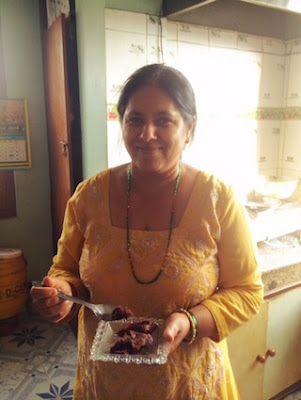Life in Nepal requires lots
of modifications. Creativity is a must!
To begin, here are just a few ways in which life is a little different:
- Unike in the US, we can’t buy everything we could possibly want in the grocery store. If you want it, you often need to figure out how to make it. Some of our favorite homemade things we would normally just buy are yogurt, ricotta cheese, crackers, english muffins, granola, pasta, and of course, ice cream.
- Doing laundry by hand.
- When there’s no gas and no hot plate, apparently you can use an iron to heat water?!?
- My pretty strong stomach is no match for the invisible bacteria found in the water. We are constantly filtering or boiling water and/or contemplating our chances when eating out in Nepal.
- Monkeys. They are all around the city. In certain areas, including the baggage claim in the airport's domestic terminal, you need to conceal all food and/or beverages. Otherwise, they'll soon belong to the monkeys.
- New bugs. Especially land leeches during the monsoons make daily walks more adventuresome, requiring regular bug spray and even soaking socks in permethrin to keep them away. And just when leech season finally ended...tick season began.
Of course, we expect that foreigners would and should adapt to their new surroundings. But now, in light of the ongoing border blockade between Nepal and India, even Nepalis are being
forced to make modifications to their daily routine. Without cooking gas, we
are revisiting how to make favorite foods with the one electrical appliance that we
have. Did you know you can make almost anything in a rice cooker? Bread –
check! Soup – check! Molten Lava Cake – you bet! Even restaurants are now advertising a “Modi”fied menu, emphasizing
the frustration with Prime Minister Modi in India who is believed to be playing
a large role in keeping needed supplies from coming into Nepal.
But as the dry winter season begins here in Nepal, electricity
is also becoming scarce. Nepal relies on hydroelectricity for power so without
consistent rain, we have a limited supply. Many of the rural areas have no
electricity at all and in the city, we have to share the
supply. This means that during a good portion of the day any given house has
no electricity. Below is our current schedule of when electricity is out each day:
 |
| Power is out during the intervals listed. |
No sector is immune to the shortages. Domestic flights have been cancelled. Public transportation has been drastically cut. (Christine's commute, as a result, went from $0.20/day to $20.00/day.) Hospitals are short on supplies and in terms of cooking for patients they've even had to resort to open fires.
 |
| Resourceful employees at the Spinal Injury Rehabilitation Centre |
Economists are predicting that the border blockade will have a larger negative impact on the country than even the major earthquakes this past spring. But while foreign aid (from India, even) poured in to help Nepal respond to that crisis, most in the world aren't even aware of the blockade, which is now into its 5th month. And so, for the unforeseeable future, it looks like we--along with the rest of the country--won't be traveling. May not be working. And will continue to cook creatively. Between the hours of noon and 4:00 p.m., that is.
















































